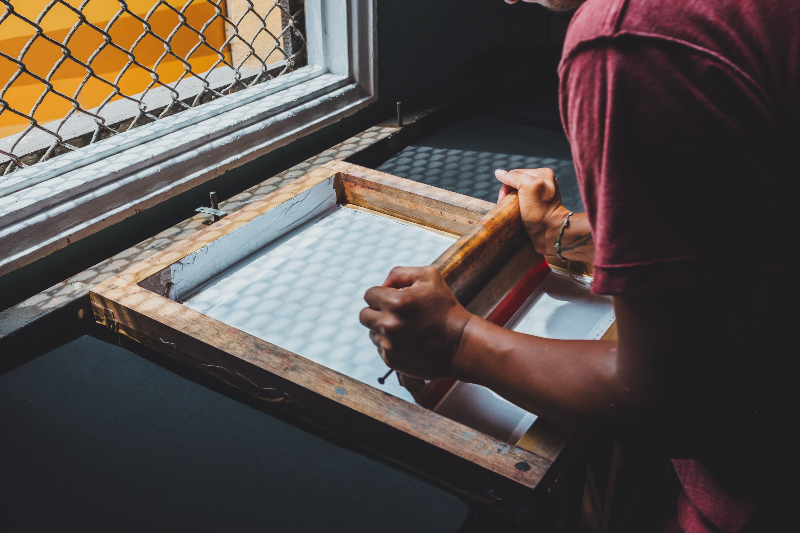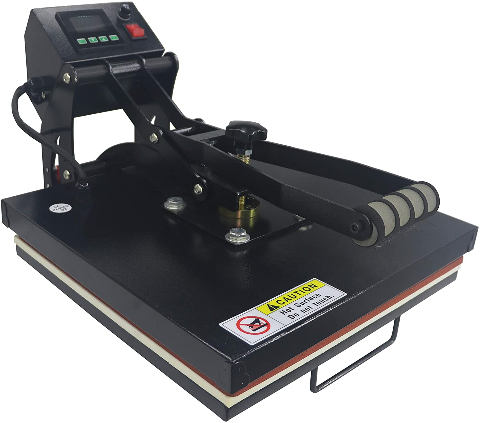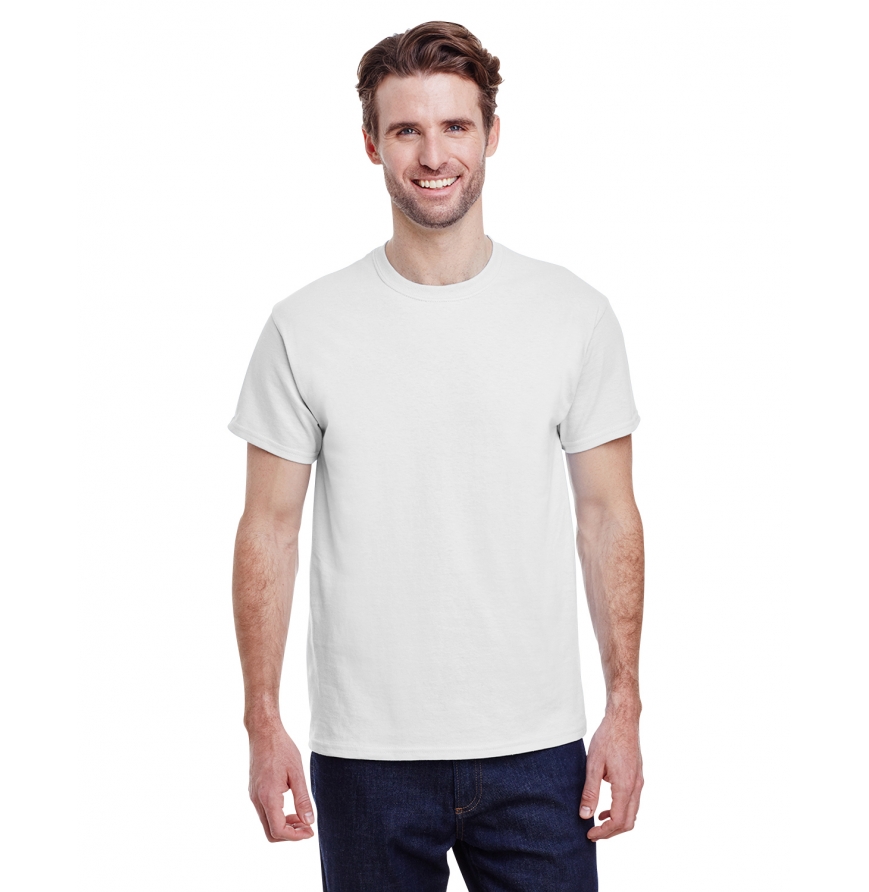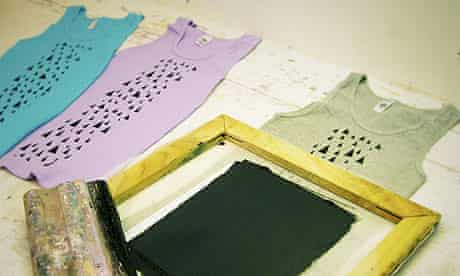

Posted by AllDayShirts on to Printing Techniques.
Deciding you want to start screen printing t-shirts is an exciting journey, but it takes some preparation. From finding the right equipment to choosing the best shirts for your designs, there are a lot of steps.
However, you don't have to spend all your money on a fancy studio with a high-tech setup. You can screen print shirts at home with a few key supplies and a little patience. Read on to learn more!
Screen printing is exactly what it sounds like: using a screen to print a design. You can print all sorts of things with this method, from clothing to posters to wood! For this article, we're going to focus on t-shirt printing.
The screens you use for this method are special polyester screens. During the process, you coat the screen with a substance called a photo emulsion and transfer a design onto the emulsion. Then, you expose the screen to UV light which reacts with the emulsion. Next, you rinse the screen, and the emulsion will rinse off where your design is, but stay on the rest of the screen, making a stencil.
The rest is easy--you put the stencil over your shirt, cover it with ink and use a squeegee to push the ink through onto the shirt. Once the ink has cured, you've officially screen printed a t-shirt! How long you expose the screen to light and how you cure the ink will depend on the emulsion and ink you choose, so always read the directions carefully.
Screen printing is one of the most common ways to print a shirt because it is flexible and easily repeatable. You can use the same stencil to print hundreds of shirts, so if you're hoping to run a t-shirt design business or print shirts for a large event, screen printing is an efficient way to make products.
Screen printing is also a versatile printing method. It works on most fabric types, including cotton and polyester, so you aren't limited to a single style. You could put the same design on as many different types of shirts as you want. While multi-color designs are time-consuming to set up, it is possible to make them, so you can use screen printing for just about any design.
Lastly, screen printing lasts well. The curing process for the ink bonds it to the fabric so if it's fully cured, the design won't crack or peel easily. Plus, the colors stay vibrant for the life of the shirt. Screen printed t-shirts are easy to wear and easy to wash.
The start-up costs can be steep, but it is cheaper than direct-to-garment printing and your results will be just as high-quality.
Screen printing does need a bit of specialized equipment. However, there are inexpensive versions of most of the supplies that you can use when you're just starting. As your screen printing business grows, you can invest in the more sophisticated versions.

Source: heatpressguide.com
The first thing you need is a screen. You can make your own or buy pre-made screens. They should be a polyester fabric mesh attached to a frame. It doesn't matter what the frame is made of as long as it will sit flat.
You'll also need your photo emulsion, a scoop coater, and a light source. A scoop coater is a trough-like tool that you use to cover the screen with the photo emulsion while keeping the texture smooth and even. Depending on the type of emulsion you choose, you might be able to cure it with a regular light or even the sun, but if you're going for speed and professionalism, a lightbox is a useful supply. Usually, you need UV rays.
If you're only planning on making a few shirts with simple designs every once in a while, you can print by hand. However, if you want to run any kind of screen printing business, you will eventually want a screen printing press.
There are manual and automatic screen printing presses. Manual presses are less expensive, but they're also more labor-intensive to run. Both kinds have a number of arms that correspond to the number of screens you can use for a given design. For example, if you have a three-color design, each color needs its own screen so you'd need a press with three arms.

Regardless of the type of press you're using, you'll also need a squeegee. The squeegee is what you'll use to press the ink through the screen stencil and onto the shirt. There are many styles and types of squeegee, and it's a matter of personal preference which one you choose.
The type of ink you choose will also determine if you need any additional supplies to cure it. Most screen printing ink has to be heat-cured, so you'll need either a heat gun, a heat press, or a conveyor dryer. A heat gun is fine for small operations, but if you're making hundreds of shirts a day, it might be time to invest in a conveyor dryer.
Making the design for your shirt can be simple. There are fancy transparency papers and printers out there for screen printing, but any inkjet printer and paper will get the job done.
Print out your design and prep it for the screen. If you use a transparency, you won't have to cut it out, but if you're using solid paper, you will want to trim back the paper until it is just your design. You should lay the design face down on the back of the screen before you expose the screen to light.
When you lay your design over your photo emulsion and expose it to light, the emulsion under your design won't cure. That's why it washes away when you rinse the screen. As long as the paper you printed on blocks enough light to keep the emulsion from curing, it will make the stencil.
Simple designs with larger shapes and fewer colors are a good idea when you're starting. As you learn your equipment and processes better, you can start experimenting with more intricate and colorful designs. This part of the process is when you can really let your creativity loose and create some beautiful screen printing art.
Of course, you'll need shirts to print on, but that's the easy part. Screen printing works on most materials and colors, so there are plenty of shirts to choose from. Because screen printing works well on so many surfaces, you can choose your shirts based on comfort and style.

Cotton shirts, like the Gildan G500, are a good choice because they're comfortable against the skin and are very heat tolerant so you're less likely to accidentally burn the shirt while you're heat-curing the ink. Cotton is also relatively inexpensive, so you can save money on your shirt supply and use any extra funds on your equipment setup instead.
Once you have your shirts and your stencils ready to go, you can start printing. This might be a few hours or a day after you started because you need your screens to be totally dry before you print.
Make sure your shirts are smooth and wrinkle-free and that all of your equipment is ready and in good working order. If you're using a printing press, you'll want to use liquid adhesive or a fabric spray adhesive to securely attach your shirts to the printing plate. If you're printing by hand, you can tape your shirts down to keep them in place during printing.
When the shirt is prepped, put your screen on top of it with the design facing up. The screen should be right on top of the shirt. Put your ink at the bottom of the design and use your squeegee to "flood" the design with ink. On the first pass, don't push down. Just run the squeegee over the design to spread the ink. Then make a second pass in the same direction, this time pushing down so that you press the ink through the screen and onto the shirt.
Carefully lift the screen off (an automatic printing press will do this part for you), and then dry the shirt. Check the instructions on your ink to get the right temperature and curing time. Once you've cured the ink, let the t-shirt dry.
Repeat as many times as you want!

Source: theguardian.com
Read the directions on your materials! Curing times and temperatures vary. You don't want to ruin your hard work accidentally.
Keep your screens flat and even so that your designs will print straight
Make sure everything dries completely between each step and, most importantly, have fun!
Screen printing t-shirts might seem intimidating at first, but once you get the hang of it, the process is fun and exciting. You can start simple and build your business gradually to an automated process.
Whatever the size of your operation, AllDayShirts.com can keep you supplied with the perfect t-shirts to show off your designs. Check out our 100% cotton t-shirts to get started today!